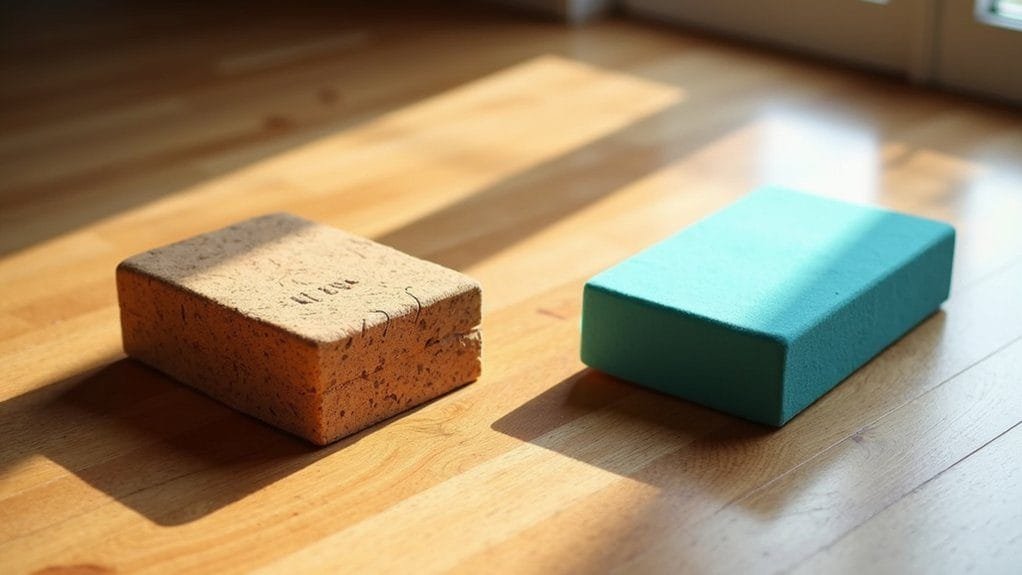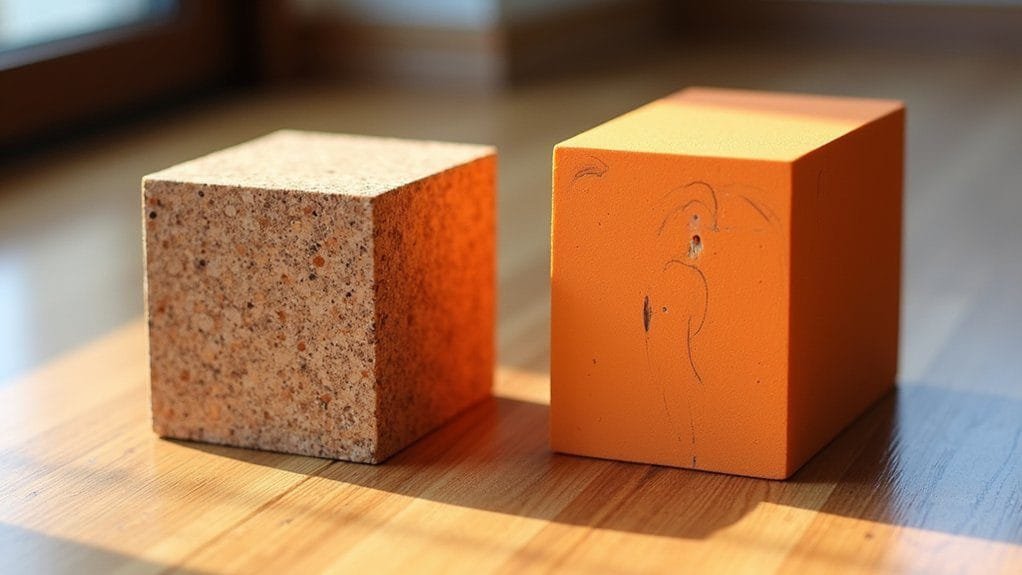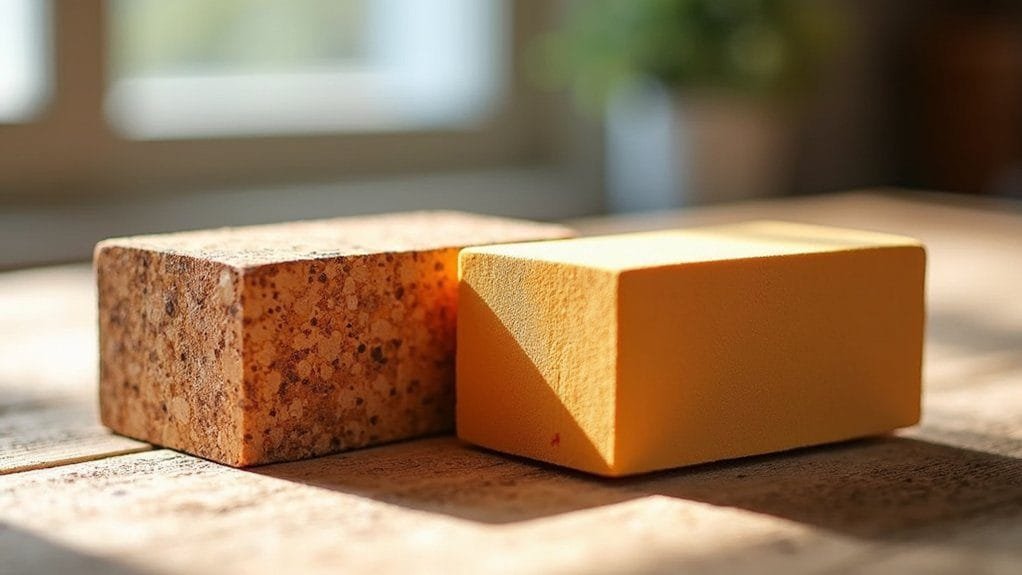When comparing cork and foam yoga blocks, cork blocks outperform foam regarding durability. Cork blocks are made from natural materials and can last over eight years, maintaining their shape and providing consistent support. In contrast, foam blocks compress under heavy loads and wear out more quickly, often requiring replacement. While cork may have a higher initial cost, its long lifespan makes it a more economical choice. Explore more factors influencing your decision for deeper insights.
Key Takeaways
- Cork yoga blocks are known for their impressive durability, often lasting over eight years without needing replacement.
- Foam yoga blocks may wear out quickly and can lose firmness after frequent use, limiting their longevity.
- Cork blocks resist nicks and dents, maintaining their shape and stability over time, making them ideal for weight-bearing poses.
- Foam blocks can compress under heavy loads, which may compromise their durability and support during more demanding exercises.
- While cork blocks have a higher upfront cost, their long lifespan makes them a more cost-effective choice for durability.
Understanding Yoga Blocks


Yoga blocks serve as essential props in the practice of yoga, enhancing both accessibility and alignment during various poses. These blocks, typically measuring around 9 by 6 by 4 inches, come in different sizes to suit diverse body types and practice requirements. You’ll find them made from materials like cork and foam, each offering distinct benefits. Cork blocks are known for their durability and eco-friendliness, providing a firm structure that supports standing poses effectively. In contrast, foam blocks are lightweight and offer a softer feel, making them suitable for restorative practices, although they may wear out more quickly. Understanding the differences between these materials can help you choose the right yoga blocks for your needs, ensuring a supportive practice.
The Advantages of Using Yoga Blocks
While many practitioners may overlook their importance, yoga blocks offer numerous advantages that greatly enhance the practice. They provide essential support and stability in various poses, making it easier to achieve proper alignment and reducing the risk of injury. Here are some key benefits:
- Deepens stretches: They help bring the ground closer, improving flexibility for those with limited range.
- Enhances comfort: Blocks improve breathing and relaxation in seated positions during restorative practices.
- Versatile use: Suitable for different skill levels and body types, they make yoga more accessible and enjoyable.
Whether you choose Cork Yoga or Foam blocks, incorporating yoga blocks into your practice can markedly enhance your experience and overall effectiveness.
Overview of Cork Yoga Blocks


Cork yoga blocks stand out as a sustainable choice for practitioners seeking both durability and stability in their practice. Made from natural, renewable materials, cork blocks provide an eco-friendly option that appeals to environmentally conscious users. Known for their impressive durability, many practitioners, like Krissy Jones, have enjoyed their cork blocks for years without needing replacements. Weighing about 2 pounds, these blocks offer solid support during various poses, enhancing safety and alignment. Their firm structure is particularly beneficial for standing and balancing postures. Additionally, the non-slip surface guarantees a reliable grip, reducing the risk of slipping during practice. Overall, cork blocks deliver both the support and stability you need for a successful yoga experience.
Overview of Foam Yoga Blocks
Foam yoga blocks offer a lightweight and cushioned alternative for practitioners looking for comfort during their practice. Made from lightweight EVA foam, these blocks weigh around 0.8 pounds, making them easy to carry and handle. While they are affordable and available in various sizes and colors, it’s essential to evaluate their limitations.
- Best suited for restorative practices and gentle poses
- Provide comfort and help with alignment
- May compress under heavier loads, limiting their use for weight-bearing exercises
The surface grip of foam blocks can vary, and they generally lack the non-slip quality found in cork blocks. Overall, foam yoga blocks serve well for those prioritizing comfort and support in their yoga sessions.
Durability Comparison: Cork vs. Foam


When considering durability, cork yoga blocks stand out for their ability to withstand years of use without significant wear. Users like Krissy Jones have reported using cork blocks for over eight years without needing a replacement. The solid structure of cork provides resistance to nicks and dents, helping maintain their shape and functionality over time. In contrast, foam yoga blocks, though lightweight and soft, tend to wear out quickly, especially during frequent weight-bearing poses. Additionally, cork blocks feature a non-slip surface that enhances grip, contributing to their longevity. While eco-friendly cork offers a durable option for rigorous practices, foam blocks are better suited for gentle, restorative sessions due to their softer composition.
Performance in Different Yoga Practices
Choosing the right yoga block can greatly impact your practice, especially when considering the demands of various styles. Cork and foam blocks each offer unique benefits, influencing your performance in different yoga practices.
- Cork blocks provide firm support, ideal for standing and balancing poses, reducing slippage risk.
- Foam blocks are lightweight and cushioned, making them great for beginners and restorative practices, although they may compress under weight.
- For advanced practitioners, cork blocks deliver durability and stability, enhancing overall performance during dynamic sequences.
Ultimately, your choice should align with your level of practice and specific yoga goals, ensuring you get the most out of your sessions.
Eco-Friendliness of Cork and Foam Blocks
While both cork and foam yoga blocks serve the same purpose, their environmental impacts differ significantly. Cork blocks are made from 100% natural and renewable materials, making them an eco-friendly option that biodegrades at the end of their life cycle. Their durability means they often last for years without needing replacement, further enhancing their sustainability. In contrast, foam blocks, typically made from petroleum-based EVA foam, contribute to plastic waste and may contain harmful chemicals. This reliance on non-renewable resources diminishes their eco-friendliness. By choosing cork yoga blocks, you support sustainable practices, while opting for foam blocks might increase your environmental footprint due to their manufacturing processes and shorter lifespan.
Factors to Consider When Choosing a Block
Selecting the right yoga block involves evaluating several key factors, including durability, grip, and eco-friendliness. Here are three essential considerations to keep in mind:
Choosing the ideal yoga block requires careful consideration of durability, grip, and eco-friendliness.
- Durability: Cork blocks, like the Manduka Cork Yoga Block, resist nicks and maintain their shape, while foam blocks may wear out quickly.
- Grip: Cork blocks offer superior grip for stability and reduced slippage, whereas foam blocks can vary in grip quality, impacting your practice.
- Eco-friendliness: Cork blocks are biodegradable and sustainable, making them a more environmentally friendly choice compared to foam blocks, which, despite being made from recycled materials, contribute to plastic waste.
User Feedback and Long-Term Use
User feedback highlights the significant advantages of cork yoga blocks over foam alternatives, particularly regarding long-term use and durability. Many users, including experienced practitioners like Krissy Jones, report that cork yoga blocks can last up to eight years without replacement. Their ability to maintain shape and stability during intense practices makes them a reliable choice for preventing injuries. Feedback shows that while foam blocks offer comfort, they tend to wear out more quickly, losing both shape and support after consistent use. Long-term users often cite the non-slip surface of cork blocks as a key factor in their durability, enhancing safety during challenging poses. Overall, user experiences strongly favor cork blocks for long-lasting performance and reliability.
Final Thoughts on Durability
When contemplating the durability of yoga blocks, cork options clearly stand out due to their robust construction and long lifespan. Cork yoga blocks are known for their exceptional longevity, making them a preferred choice for serious practitioners. Here are some key points to contemplate:
- Cork blocks resist nicks and maintain their shape, ensuring long-lasting performance.
- Users report years of reliable use without significant wear, unlike foam yoga blocks.
- Foam blocks can compress and get dirty quickly, requiring more frequent replacements.
Frequently Asked Questions
Is Cork or Foam Better for Yoga Blocks?
When choosing yoga blocks, consider eco-friendly options like cork for durability and grip quality. Weigh price differences against performance; cork tends to be sturdier, while foam offers portability and a softer feel for beginners.
What Is the Best Material for a Yoga Block?
Choosing a yoga block’s material is like selecting a sturdy ship for your journey. Consider eco-friendly options like cork for durability, or foam for comfort. User experience feedback often highlights performance differences in various block materials.
How Durable Are Cork Yoga Mats?
Cork yoga mats are durable due to cork sustainability and texture. With proper maintenance, they maintain excellent grip, resisting wear and providing stability during practice. Their natural properties enhance longevity, making them a reliable choice for yogis.
Which Is Better Cork or Rubber Yoga Mat?
When comparing cork and rubber yoga mats, consider cork benefits like firmer grip effectiveness and eco-friendliness, while foam advantages include lightweight portability and cushioning. Analyze the material comparison based on your practice style and preferences.
What Yoga Block Is Best for Wrist Pain?
For wrist pain, consider a cork yoga block for better wrist support. Its thickness offers pressure relief and acts as a solid alignment aid, ensuring proper posture during poses, ultimately reducing strain and discomfort in your wrists.
Do Yoga Blocks Made of Cork or Foam Provide Better Support for Flexibility Improvements?
When considering the best materials for improving flexibility in yoga, both cork and foam yoga blocks have their unique advantages. Cork, being denser, offers a stable support that can enhance alignment, while foam blocks are lightweight and versatile. Ultimately, each type of yoga blocks flexibility benefits cater to individual preferences and needs.
Conclusion
In conclusion, when it comes to durability, cork yoga blocks often outlast their foam counterparts, thanks to their robust resistance to wear and tear. However, foam blocks provide a lighter, softer alternative that some users prefer. Ultimately, your choice should reflect your personal practice and preferences. Weigh the weighty benefits of each option, considering factors like firmness, feel, and functionality, to find the perfect fit for your yoga journey.
